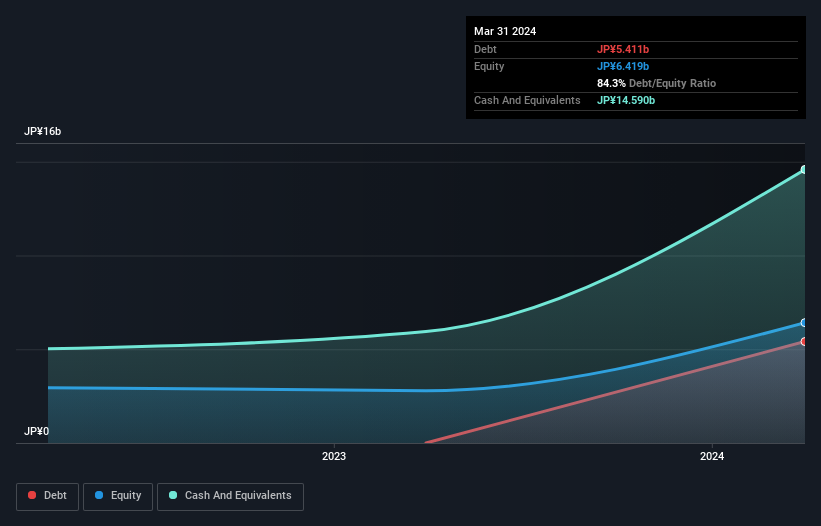Some say volatility, rather than debt, is the best way to think about risk as an investor, but Warren Buffett famously said that 'Volatility is far from synonymous with risk.' So it might be obvious that you need to consider debt, when you think about how risky any given stock is, because too much debt can sink a company. We can see that Kusurinomadoguchi, Inc. (TSE:5592) does use debt in its business. But is this debt a concern to shareholders?
When Is Debt A Problem?
Debt and other liabilities become risky for a business when it cannot easily fulfill those obligations, either with free cash flow or by raising capital at an attractive price. In the worst case scenario, a company can go bankrupt if it cannot pay its creditors. However, a more usual (but still expensive) situation is where a company must dilute shareholders at a cheap share price simply to get debt under control. By replacing dilution, though, debt can be an extremely good tool for businesses that need capital to invest in growth at high rates of return. When we examine debt levels, we first consider both cash and debt levels, together.
See our latest analysis for Kusurinomadoguchi
What Is Kusurinomadoguchi's Net Debt?
You can click the graphic below for the historical numbers, but it shows that as of March 2024 Kusurinomadoguchi had JP¥5.41b of debt, an increase on none, over one year. But it also has JP¥14.6b in cash to offset that, meaning it has JP¥9.18b net cash.

How Healthy Is Kusurinomadoguchi's Balance Sheet?
We can see from the most recent balance sheet that Kusurinomadoguchi had liabilities of JP¥16.0b falling due within a year, and liabilities of JP¥695.0m due beyond that. Offsetting this, it had JP¥14.6b in cash and JP¥3.34b in receivables that were due within 12 months. So it actually has JP¥1.28b more liquid assets than total liabilities.
This short term liquidity is a sign that Kusurinomadoguchi could probably pay off its debt with ease, as its balance sheet is far from stretched. Simply put, the fact that Kusurinomadoguchi has more cash than debt is arguably a good indication that it can manage its debt safely.
On top of that, Kusurinomadoguchi grew its EBIT by 30% over the last twelve months, and that growth will make it easier to handle its debt. When analysing debt levels, the balance sheet is the obvious place to start. But you can't view debt in total isolation; since Kusurinomadoguchi will need earnings to service that debt. So if you're keen to discover more about its earnings, it might be worth checking out this graph of its long term earnings trend.
Finally, a business needs free cash flow to pay off debt; accounting profits just don't cut it. While Kusurinomadoguchi has net cash on its balance sheet, it's still worth taking a look at its ability to convert earnings before interest and tax (EBIT) to free cash flow, to help us understand how quickly it is building (or eroding) that cash balance. In the last three years, Kusurinomadoguchi's free cash flow amounted to 32% of its EBIT, less than we'd expect. That's not great, when it comes to paying down debt.
Summing Up
While it is always sensible to investigate a company's debt, in this case Kusurinomadoguchi has JP¥9.18b in net cash and a decent-looking balance sheet. And we liked the look of last year's 30% year-on-year EBIT growth. So is Kusurinomadoguchi's debt a risk? It doesn't seem so to us. When analysing debt levels, the balance sheet is the obvious place to start. However, not all investment risk resides within the balance sheet - far from it. These risks can be hard to spot. Every company has them, and we've spotted 2 warning signs for Kusurinomadoguchi you should know about.
At the end of the day, it's often better to focus on companies that are free from net debt. You can access our special list of such companies (all with a track record of profit growth). It's free.
Valuation is complex, but we're here to simplify it.
Discover if Kusurinomadoguchi might be undervalued or overvalued with our detailed analysis, featuring fair value estimates, potential risks, dividends, insider trades, and its financial condition.
Access Free AnalysisHave feedback on this article? Concerned about the content? Get in touch with us directly. Alternatively, email editorial-team (at) simplywallst.com.
This article by Simply Wall St is general in nature. We provide commentary based on historical data and analyst forecasts only using an unbiased methodology and our articles are not intended to be financial advice. It does not constitute a recommendation to buy or sell any stock, and does not take account of your objectives, or your financial situation. We aim to bring you long-term focused analysis driven by fundamental data. Note that our analysis may not factor in the latest price-sensitive company announcements or qualitative material. Simply Wall St has no position in any stocks mentioned.
Have feedback on this article? Concerned about the content? Get in touch with us directly. Alternatively, email editorial-team@simplywallst.com
About TSE:5592
Kusurinomadoguchi
Provides solutions for pharmacies and medical care in Japan.
Outstanding track record with adequate balance sheet.
Market Insights
Community Narratives



